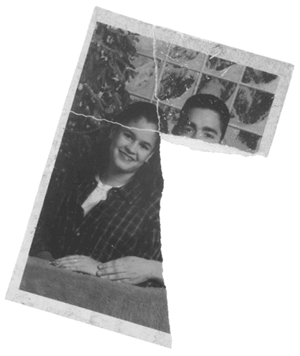
REVIEW
Joachim Schmid
Museum of Contemporary Photography
through October 13
Turning Photo-Trash into Art Treasure
Found photographs engage as artworks in Joachim Schmid's Pictures from the Street
 | No. 217, Los Angeles, March 1994 |
By Laura Thompson
Having your picture taken can all too often be an experience of unease, filled with apprehension about the outcome. Photography can be intrusive, slicing 1/250 of a second out of your life when you're not ready, and confronting you, later, with this wild-eyed or seemingly half-drugged, slouching version of yourself.
My ID card and UPass pictures are both awful and impossibly different: in one I am shiny and jubilant; in the other, blurry and distressed. But they were taken on a completely average day, indeed within minutes of each other. At some point everyone is confronted with a bad picture of him or herself.
It's as if a bad photograph has the potential to divulge your "true" nature - graceless, drunk, mad. The real, composed, nice "You" is just a scam, and here is the evidence to prove it. We are compelled to get rid of them, tear them up, or hide them. Or maybe you have ripped up a picture of a person you are angry with in a cathartic act of revenge. In any case, you reject the image of the event because it does not sufficiently or pleasantly echo what you remember, what once seemed worth recording on film. No longer valuable, these pictures become clutter, litter.
But as the saying goes: One person's trash is another's treasure. For nearly 20 years German conceptual artist Joachim Schmid has been turning such photo-trash into treasure, or at least, art. To date, Schmid has collected 714 photographs from streets around the world, showing viewers what others like them possibly wanted to forget, or perhaps just accidentally dropped in transit.
Indeed there is infinite space for interpretation in Schmid's Pictures from the Street series (1982 - present), approximately 100 of which are on display at The Museum of Contemporary Photography at Columbia College through October 13. What is most striking is the number of torn-up pictures, and the effect of their reconstruction. Schmid pieces these photos back together like puzzles. In the end, the rough edges and creases are still visible and often compete with the imagery, a bit of violence that disrupts an otherwise innocent face or embracing couple. And oftentimes not every piece is found. These incomplete images, too, are loaded with suggestions of tragic sagas.
 | No. 5, Berlin, April 1993 |
Some seem too good to be true: in "No. 217, Los Angeles, March 1994" a young couple poses in a portrait studio in front of a Christmas tree, but a chunk of the image where the man stands is missing, implying perhaps a division or tragedy in their relationship. But of course the real story behind the photo will never be known. Like "No. 217," some are easy to interpret. You can imagine why a woman might tear up a picture of herself wearing lingerie ("No. 462, Rio de Janeiro, December 1996") or one of her ex, grinning obnoxiously in a baseball cap ("No. 259, Berlin, April 1995"), but why would someone destroy a photo of graffiti ("No. 434, Berlin, October 1996") or two children in their winter coats ("No. 525, Brighton, October 1997")?
 | No. 111, Berlin, August 1991 |
Torn pictures have been acted upon for reasons we can only guess. It is equally likely that many of the pictures in Schmid's collection were not in fact maliciously destroyed but, rather, simply lost, dropped by accident and damaged on the street. The open-ended experience of finding a picture or simply looking at a found photograph like those in Pictures from the Street is a feast for the mind. Even the most mundane photograph becomes captivating and cryptic when it is lost and then found by someone else. Not only can you gaze unobstructed into the lives of random people, but you can fabricate the details of their existence. By collecting and showing these otherwise lost photos, Schmid liberates them from any ties to specific representation.
The expansive nature of found photography is enhanced by Pictures from the Street's presentation. The exhibition is refreshingly devoid of an artist or curator's hand. Rather than subjectively choosing photos, Schmid mathematically determines each exhibition according to a gallery's size and the number of images in his collection-showing, therefore, say, every seventh picture, organized chronologically by the date it was found. As a result, an earnest passport photograph receives no more prominence or value than a lone, torn black corner of an otherwise absent image.
 | No. 75, Berlin, May 1990 |
Further, Schmid's finds are presented with a pleasingly minor level of preciousness: each is displayed on cream-colored paper held to the wall by two nails, effecting a sort of casual bulletin-board feel. Some still show signs of dirty footprints or weather damage. I was disappointed that the first picture that Schmid collected was not included in the show: one wonders what sort of photo could have spurred his elaborate dedication to the project? His most recent find, however, is included: a picture found on the street in Chicago during the installation of the exhibition. I haven't seen it yet (I visited the show during its installation). I'm hoping it's not my old UPass.
|

